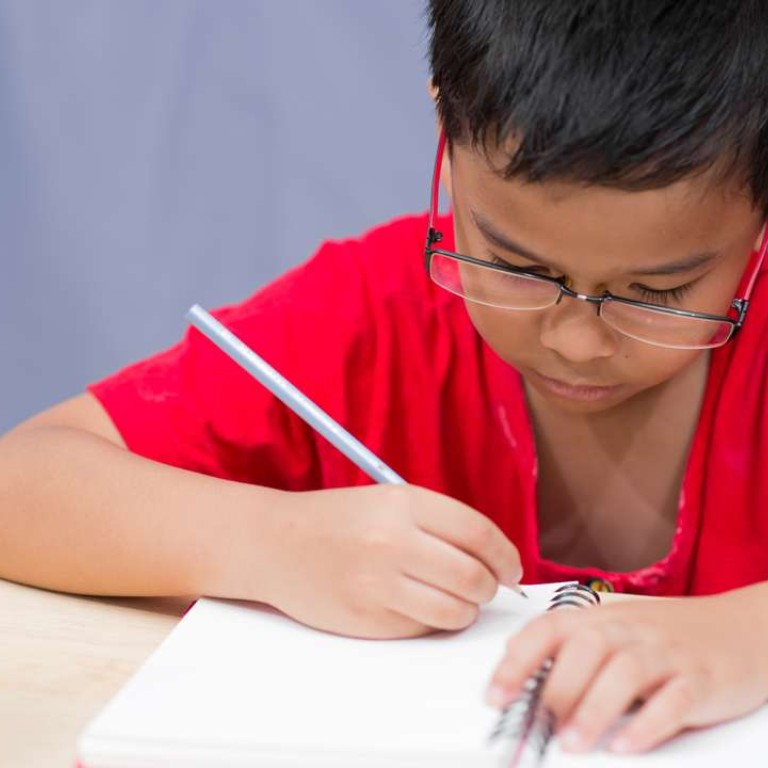
Why digital natives must still learn handwriting: so they can pass Hong Kong exams (and write birthday cards)
Children sometimes struggle to write joined-up letters in their early years in primary school, but they should master cursive handwriting because it helps them think – and they’ll need it in exams
A Hong Kong parent writes: my son could write all the letters of the alphabet by the age of four. His Year Two teacher says he needs to join up his letters, but he wants to keep them separate. The pressure to join them up is making him reluctant to write. How important is cursive writing?

Much of the educational research about writing highlights the value and importance using cursive handwriting. Studies show that joining letters not only helps to increase the speed at which children work but crucially aids their mental processing skills, helping them to think more fluently.
Additionally, it has been shown that cursive writing helps children improve their spelling accuracy. Writing letters in groups that have meaning (phonemes) rather than in isolation can aid the long-term memory of spellings and also builds up comprehension skills.
However, cursive writing can feel confusing and a little overwhelming to start with. Your son has gained confidence in writing each letter of the alphabet as a separate entity and has grown used to printing letters over several years. Therefore it’s perfectly normal for him to find the transition to cursive writing difficult. He will probably take a short dip in confidence until he masters the skill – which only comes with practise.
Some primary schools begin to teach cursive writing as soon as children enter Year One. Often, pupils know the letters of the alphabet and are ready to move on to the next stage of using a more flowing and natural style of writing. Although this approach can appear more difficult initially, as individual letters become less clear, it can be easier than converting from printed to joined letters at an older age. Sometimes teachers insist that each letter is formed from the baseline so that pupils naturally, and often seamlessly, progress to cursive writing.

It is definitely worth sticking at it. A cursive style of writing would ensure that your son avoids bad writing habits due to printing poorly formed letters (which can look correct but may be formed incorrectly). You will find that, as he gets older, teachers will spend less time on handwriting exercises as the groundwork should have been done in the earlier years.
If he continues to struggle with the whole process, discuss with his teacher ways in which you can support him. Ask for some guidance as to how to help him at home so you can check that he is using the correct technique. Also ask about school requirements and expectations, because even in schools where cursive writing is compulsory, not all teachers will enforce it.
Getting the right pencil grip at this stage is also crucial to future writing success. An incorrect grip can be overlooked by a teacher with a large class of children, so it is worth checking this as well. Once bad habits are ingrained they are very hard to change and unlearn.
Your son should focus on developing a smooth, cursive style of writing. His hand should be firm but relaxed and the paper well supported and slightly tilted, steadied with his other hand. Once he becomes more confident he will build up fluency and speed. The more he uses it the more it will become a comfortable habit.
Sometimes older primary students take it upon themselves to start printing their letters again, seeing it as “cool” or “grown up”. This is very misguided, as the sheer amount of note taking and work demands in secondary school require the speed of cursive writing more than ever.

Having said that, most Hong Kong international schools require students to have their own laptop from Year Seven onwards, so homework and note taking is often done on the computer. This can mean, however, that some pupils flounder at exam time when expected to legibly hand-write a large amount of text in a short space of time. It’s possible that by the time your son is taking his final exams he may be required to type his answers, but not all schools in Hong Kong or abroad have such a high level of access to technology, so this may happen later rather than sooner.
Due to the technological age, handwriting is less important than it used to be. However, having a neat and beautiful cursive handwriting script is a great skill that children can be proud of. There is nothing like receiving a handwritten greeting card, postcard or thank you letter.
Julie McGuire is a former Hong Kong primary school teacher
